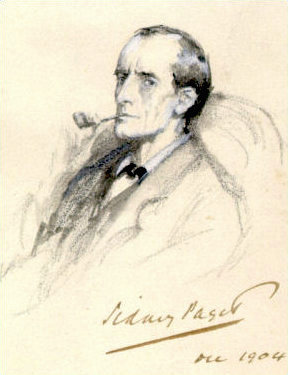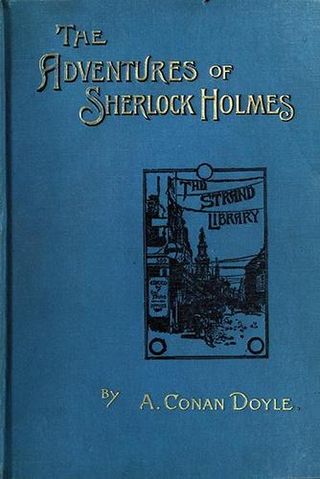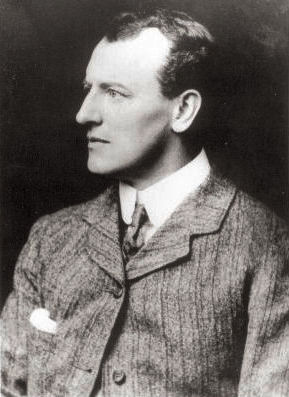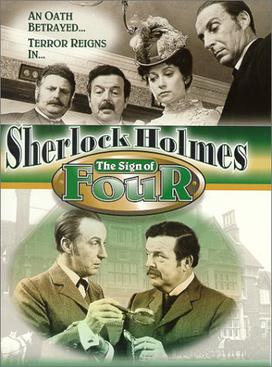
Detective fiction is a subgenre of crime fiction and mystery fiction in which an investigator or a detective—whether professional, amateur or retired—investigates a crime, often murder. The detective genre began around the same time as speculative fiction and other genre fiction in the mid-nineteenth century and has remained extremely popular, particularly in novels. Some of the most famous heroes of detective fiction include C. Auguste Dupin, Sherlock Holmes, and Hercule Poirot. Juvenile stories featuring The Hardy Boys, Nancy Drew, and The Boxcar Children have also remained in print for several decades.

Sherlock Holmes is a fictional detective created by British author Arthur Conan Doyle. Referring to himself as a "consulting detective" in the stories, Holmes is known for his proficiency with observation, deduction, forensic science and logical reasoning that borders on the fantastic, which he employs when investigating cases for a wide variety of clients, including Scotland Yard.

A Study in Scarlet is an 1887 detective novel by British writer Arthur Conan Doyle. The story marks the first appearance of Sherlock Holmes and Dr. Watson, who would become the most famous detective duo in literature. The book's title derives from a speech given by Holmes, a consulting detective, to his friend and chronicler Watson on the nature of his work, in which he describes the story's murder investigation as his "study in scarlet": "There's the scarlet thread of murder running through the colourless skein of life, and our duty is to unravel it, and isolate it, and expose every inch of it."

The Adventures of Sherlock Holmes is a collection of twelve short stories by British writer Arthur Conan Doyle, first published on 14 October 1892. It contains the earliest short stories featuring the consulting detective Sherlock Holmes, which had been published in twelve monthly issues of The Strand Magazine from July 1891 to June 1892. The stories are collected in the same sequence, which is not supported by any fictional chronology. The only characters common to all twelve are Holmes and Dr. Watson and all are related in first-person narrative from Watson's point of view.

221B Baker Street is the London address of the fictional detective Sherlock Holmes, created by author Sir Arthur Conan Doyle. In the United Kingdom, postal addresses with a number followed by a letter may indicate a separate address within a larger, often residential building. Baker Street in the late 19th century was a high-class residential district, and Holmes's apartment would probably have been part of a Georgian terrace.

His Last Bow: Some Reminiscences of Sherlock Holmes is a 1917 collection of previously published Sherlock Holmes stories by British writer Arthur Conan Doyle, including the titular short story, "His Last Bow. The War Service of Sherlock Holmes" (1917). The collection's first US edition adjusts the anthology's subtitle to Some Later Reminiscences of Sherlock Holmes. All editions contain a brief preface, by "John H. Watson, M.D.", that assures readers that as of the date of publication Holmes is long retired from his profession of detective but is still alive and well, albeit suffering from a touch of rheumatism.

Sidney Edward Paget was a British artist of the Victorian era, best known for his illustrations that accompanied Arthur Conan Doyle's Sherlock Holmes stories in The Strand Magazine.

Detective Inspector G. Lestrade, or Mr. Lestrade, is a fictional character appearing in several of the Sherlock Holmes stories written by Arthur Conan Doyle. Lestrade's first appearance was in the first Sherlock Holmes story, the novel A Study in Scarlet, which was published in 1887. The last story in which he appears is the short story "The Adventure of the Three Garridebs", which was first published in 1924 and was included in the final collection of Sherlock Holmes stories by Doyle, The Case-Book of Sherlock Holmes.

"The Adventure of the Dying Detective", in some editions simply titled "The Dying Detective", is one of the 56 Sherlock Holmes short stories written by Sir Arthur Conan Doyle. It was originally published in Collier's in the United States on 22 November 1913, and The Strand Magazine in the United Kingdom in December 1913. Together with seven other stories, it was collected in His Last Bow.

Arthur George Morrison was an English writer and journalist known for realistic novels, for stories about working-class life in the East End of London, and for detective stories featuring a specific detective, Martin Hewitt. He also collected Japanese art and published several works on the subject. Much of his collection entered the British Museum, through purchase and bequest. Morrison's best known work of fiction is his novel A Child of the Jago (1896).

Sherlock Holmes is the overall title given to the series of Sherlock Holmes adaptations produced by the British television company Granada Television between 1984 and 1994. The first two series were shown under the title The Adventures of Sherlock Holmes and were followed by subsequent series with the titles of other short story collections by Sir Arthur Conan Doyle.
The stories of Sherlock Holmes by Sir Arthur Conan Doyle have been very popular as adaptations for the stage, and later film, and still later television. The four volumes of the Universal Sherlock Holmes (1995) compiled by Ronald B. De Waal lists over 25,000 Holmes-related productions and products. They include the original writings, "together with the translations of these tales into sixty-three languages, plus Braille and shorthand, the writings about the Writings or higher criticism, writings about Sherlockians and their societies, memorials and memorabilia, games, puzzles and quizzes, phonograph records, audio and video tapes, compact discs, laser discs, ballets, films, musicals, operettas, oratorios, plays, radio and television programs, parodies and pastiches, children's books, cartoons, comics, and a multitude of other items — from advertisements to wine — that have accumulated throughout the world on the two most famous characters in literature."

Sherlock Holmes has long been a popular character for pastiche, Holmes-related work by authors and creators other than Arthur Conan Doyle. Their works can be grouped into four broad categories:

The Rivals of Sherlock Holmes is a British anthology mystery television series produced by Thames Television which was originally broadcast on the ITV Network. There were two series of 13 fifty-minute episodes; the first aired in 1971, the second in 1973. The programme presented adaptations of short mystery, suspense or crime stories featuring, as the title suggests, detectives who were literary contemporaries of Arthur Conan Doyle's Sherlock Holmes.
Max Carrados is a fictional blind detective in a series of mystery stories and books by Ernest Bramah, first published in 1914. The Max Carrados stories appeared alongside Sherlock Holmes stories in the Strand Magazine. Bramah was often billed above Arthur Conan Doyle, and the Carrados stories frequently outsold the Holmes stories at the time, even if they failed to achieve the same longevity.

John H. Watson, known as Dr. Watson, is a fictional character in the Sherlock Holmes stories by Sir Arthur Conan Doyle. Along with Sherlock Holmes, Dr. Watson first appeared in the novel A Study in Scarlet (1887). "The Adventure of Shoscombe Old Place" (1927) is the last work of Doyle featuring Watson and Holmes, although their last appearance in the canonical timeline is in "His Last Bow" (1917).
This article describes minor characters from the Sherlock Holmes stories by Sir Arthur Conan Doyle, and from non-canonical derived works. The list excludes the titular character as well as Dr. Watson, Professor Moriarty, Inspector Lestrade, Mycroft Holmes, Mrs. Hudson, Irene Adler, Colonel Moran, the Baker Street Irregulars, and characters not significant enough to mention.

The Sign of Four is a 1983 British made-for-television mystery film directed by Desmond Davis and starring Ian Richardson and David Healy. The film is based on Sir Arthur Conan Doyle's 1890 novel of the same name, the second novel to feature Sherlock Holmes and Doctor Watson.

Sherlock Holmes is a four-act play by William Gillette and Sir Arthur Conan Doyle, based on Conan Doyle's character Sherlock Holmes. After three previews it premiered on Broadway November 6, 1899, at the Garrick Theatre in New York City.
From 1921 to 1923, Stoll Pictures produced three series of silent black-and-white films based on Sir Arthur Conan Doyle's Sherlock Holmes stories. Forty-five short films and two feature-length films were produced featuring Eille Norwood in the role of Holmes and Hubert Willis cast as Dr. Watson with the exception of the final film, The Sign of Four, where Willis was replaced with Arthur Cullin. Consequently, Norwood holds the record for most appearances as Sherlock Holmes in film.
















